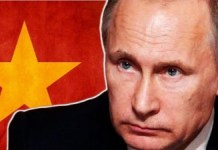The enhancements in weapons technology across the globe mean that the trigger to cause mass destruction can also fall in the hands of terrorists or extremist groups, thereby enforcing each nation to field its own special counter-terrorism force, much like the American ‘SWAT’ or Russia’s ‘SOBR’.
Indian Navy’s Surveillance Capabilities To Receive Boost With 10 Shipborne Drones
Known by the name of the Special Rapid Response Unit or SOBR (Spetsial’nyy Otryad Bystrogo Reagirovaniya), the special Russian force deals with the majority of the terrorism incidents within the nation.
It is a Spetsnaz (Russian language umbrella term for Special Forces) unit of the National Guard of Russia, which stands as the internal military force of the Russian government. The National Guard of Russia comprises an independent agency reporting directly to President Vladimir Putin.
While most people will be familiar with the Russian Federal Security Service’s (FSB) dedicated counter-terrorism elite task force ‘Alpha’ unit, the SOBR Special Forces, on the other hand, handles most armed incidents across the country.
These include countering incidents ranging from Chechen militants holed up in their houses to handling domestic-violence standoffs. The units constitute a rapid-reaction and rapid-insertion military forces available to the regular police and can be compared to the United States’ SWAT (Special Weapons and Tactics) law enforcement unit.

Their origin, like many elite police teams of Europe, began in the aftermath of the attacks on the 1972 Munich Olympic Games, with the Soviet Union fielding its first special police unit on November 09, 1978.
The unit was formed under the authority of the Soviet MVD (Ministry of Internal Affairs) under order number 0707, in preparations for the 1980 Summer Olympics in Moscow.
Known back then as OMON, which stood for “special-purpose police force”, SOBR was the first elite police unit which was formed to respond to difficult situations in the region, with November 09 now celebrated as SOBR Day in Russia.
Following the completion of the Summer Olympics, in 1981, SOBR tasted its first action, when they captured a man who had barricaded himself in an apartment after shooting a young girl and her father using a hunting rifle.
However, unlike how things used to work in the Soviet era, in present-day Russia, the roles of the SOBR teams are different from the units which are now called OMON.
While OMON is largely tasked with the responsibility for public security and control, SOBR’s focus is directed on small tactical actions which include hostage rescues, dealing with armed situations, and witness protection.
The teams also possess negotiators in order to resolve situations in a peaceful manner, in a similar way as FSB’s elite Alpha team.
The recruits are taken out from the regular police, who then go through a competitive selection process. However, preference is given to the recruits who have served in the VDV (paratroopers) and the Army Spetsnaz (SpN).
Following the end of the recruitment process, the members go through psychological testing before joining the unit. They are then training in close-quarters marksmanship, hand-to-hand fighting, and urban assault techniques like rappelling.
The assault groups are normally armed with a combination of a ballistic shield and an array of assault rifles, pistols, and submachine guns.
Moreover, there is usually a support element to the unit which covers the building with heavy weapons and sniper rifles in order to keep the enemies under pressure.
Like every special task force unit has its own set of equipment that helps them carry out the tasks, the level of equipment for the SOBR units depends mostly on the threat as well as the funding of the region.
While the SOBR teams from wealthier cities like the SOBR “Viking” from Kaliningrad possess American weapon accessories and camouflage, teams belonging to comparatively poorer cities such as SOBR “Rubin” from Novgorod Oblast, make use of stock army-issue AK-74Ms and nineties-era assault helmets.
However, the best-equipped teams include the SOBR “Granit” from St. Petersburg and SOBR “Bulat” from Moscow Oblast.
Interestingly though, the narrow and specific nature of the tasks at hand for SOBOR units as compared to the OMON is one of the reasons for special units to have a very small strength in numbers, with SOBOR possessing 5,200 members as compared to OMON’s 40,000.
Follow EurAsian Times on Google News




